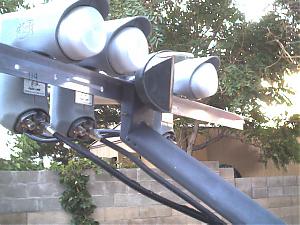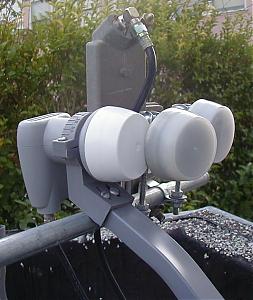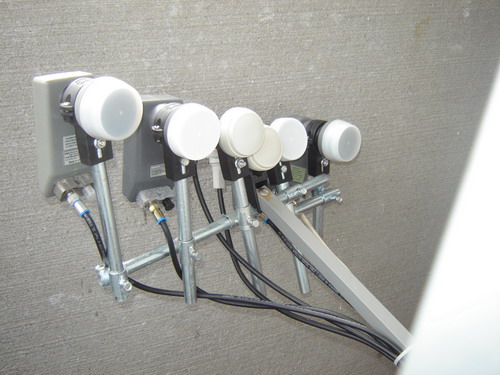Dishes & LNB's
|
Bronze Member Username: PaintPost Number: 32 Registered: Mar-06 | Want to upgrading from poorman's dish. What's best/cost effective combination of dish & LNB's to see 110,119, & 121? Would like to feed 2 3500's. LK, have any knowledge of using FTA receivers with c band? |
|
Gold Member Username: LklivesPost Number: 1988 Registered: Jan-06 | C band info is best at al7bar.t*k....buy a used superdish from a DSS forums with buy/sell area, made just for that..or buy a cheap 30 inch dish and make your own poormans superdish..I have pics here on other threads..this has 4 lnb's 91-110-119-121...notice how the 119 blocks part of the 121 LNB, cause they are so close..   |
|
Bronze Member Username: PaintPost Number: 34 Registered: Mar-06 | Thanks LK, you should publish book, for educational purpose only!! |
|
New member Username: NamnguyenkyMississauga, Ontario Canada Post Number: 1 Registered: Apr-06 | I USE 39' EAGLE STAR WITH BRACKET AND GET 82,91,T5,AMC4,110,119 TRYING TO GET 121 BUT NO LUCK CAN ANYONE GIVE ME AN IDEA (FROM TORONTO CANADA) THANKS  |
|
Gold Member Username: LklivesPost Number: 1998 Registered: Jan-06 | That photo does have the 121.. |
|
Bronze Member Username: 1iramboPost Number: 23 Registered: Apr-06 | LK, I have a 10ft dish for my 4dtv. I also have an extra 10ft that I thought to keep around cause maybe I can install multiple lnbs. Is this possible? Is it a waste of time? If it will work what sats are able to be picked up? |
|
Bronze Member Username: 1iramboPost Number: 24 Registered: Apr-06 | Also I have extra actuator but Im not thinking of motorizing this setup. Just looking for premium stationary pos and max #lnbs. With additional pansat. |
|
Gold Member Username: LklivesPost Number: 2007 Registered: Jan-06 | 10 ft dishes are BIG and UGLY..not needed unless doing C band.. |
|
Bronze Member Username: 1iramboPost Number: 28 Registered: Apr-06 | I thought it might work? they are big and ugly, but we are well out of town,(middle of nowhere) and just wondering if there would be any advantage with the bigger reflector? If a 30" would do the same thing maybe that would be the way to go? |
|
Gold Member Username: LklivesPost Number: 2013 Registered: Jan-06 | It all depends what your SPECIFIC goal is...U might want to do some reading at al7bar.t*k about BIG dishes...get some good info there, ideas, pro's and con's..they have a BIG Dish area.. |
|
Bronze Member Username: 1iramboPost Number: 32 Registered: Apr-06 | thanks,will check out |
|
Bronze Member Username: PaintPost Number: 37 Registered: Mar-06 | Originally posted by LK -------------------------------------------------------------------------------- OK everyone, put your polarizing sunglasses on. What's the difference? Answer: About -3dB or half the signal level. Now take your sunglasses off. Notice how bright it is in here? The difference in brightness is an example of using the wrong lnb type. Circular and Linear polarization refer to the characteristics of the radio wave that is transmitted by the satellite towards your dish/LNB. Below are links to visual comparisons of Circular (Left or Right-hand) and Linear (Vertical or Horizontal) polarization. http://www.lyngsat.c o m/echo3.html Nimiq 2 @82.0°W http://www.lyngsat.com/nimiq2.html Nimiq 1/3 @91.0°W http://www.lyngsat.com/nimiq1.html EchoStar 6/8 @110.0°W http://www.lyngsat.com/110west.html EchoStar 7 @119.0°W http://www.lyngsat.com/echo7.html EchoStar 1/2 @148.0°W http://www.lyngsat.com/148west.html How do I know they are circularly polarized? If you click on any one of the links for the satellites above you will notice that under the first column labeled as "Freq. Tp" you will find one of the following single letter designations: "R" = right-hand (=circular polarization) "L" = left-hand (=circular polarization) So what about linear polarization? Linear polarization refers to a wave of radio signal rotating in a single plane. Think of an approaching helicopter as the helicopter's main rotor is moving towards you. It is rotating in a single, horizontal plane. The same approaching helicopter's smaller rear rotor is rotating in a single, vertical plane. In our satellite case it can be either in the "H"orizontal or "V"ertical plane. The following example satellites (visable in N.America) are transmitting with a linear polarized signal: SBS 6 @74.0°W http://www.lyngsat.com/sbs6.html AMC 5 @79.0°W http://www.lyngsat.com/amc5.html AMC 9 @85.0°W http://www.lyngsat.com/amc9.html IA 6 @93.0°W http://www.lyngsat.com/ia6.html IA 5 @97.0°W http://www.lyngsat.com/ia5.html AMC 1 @103.0°W http://www.lyngsat.com/amc1.html AMC 2 at 105.0°W http://www.lyngsat.com/amc2.html EchoStar 9 @121.0°W http://www.lyngsat.com/echo9ia13.html Again, under the first column labeled as "Freq. Tp" you will find one of the following single letter designations: "V" = vertical (=linear polarization) "H" = horizontal (=linear polarization) Now that you understand the difference between the two satellite polarization types please put your polarizing sunglasses back on. Hmmm, a little harder to read this right? Well, that's what happens to your receiver when you try to use a linear polarized LNB to receive a circular polarized satellite signal and vis-a-versa. About a 50% loss of signal! Armed with the invaluable information you now possess, by using this link http://www.lyngsat.com/america.html you can determine for yourself what type of LNB you will need for each satellite. If you need a circular polarized LNB look for words describing it as "DSS" or "DBS" or "circular" or a combination of these terms. If you need a linear polarized LNB look for words describing it as "FSS" or "FTA" or "linear" or a combination of these terms (FYI: All Universal LNB's are linear LNB's). -------------------------------------------------------------------------------- Quote: ...you could use linear LNB to get circular signal with 50% signal lost. You will need a large dish to compensate for this loss. Quote: ...you can't use circular LNB to get linear signal. Technically incorrect. Trying to receive linear polarized signals with a circular polarized lnb (antenna) is possible with the same 3dB/50% loss of signal. The actual reason why you most likely cannot receive linear signals with circular lnb's is because most all "DSS" circular polarized lnb's are incapable of receiving the frequecies at which linear FSS signals occur: Standard FSS LNB (11.7-12.2 GHz) -------->DSS LNB (12.2-12.75 GHz) Universal FSS LNB (10.7-12.75 GHz) <-- has wide bandwidth |
|
New member Username: Bobie70Post Number: 2 Registered: Apr-06 | any body nkow about if I can used a LNB from starchoice or the dish, for see 110 or 119 satellite |
|
Gold Member Username: LklivesPost Number: 2058 Registered: Jan-06 | Starchoice are linear LNB's...NFG for 110-119, which are circular..the dish is OK..its just a hunk a metal that reflects signals to the LNB's.. |
|
New member Username: Jlatacela1Post Number: 5 Registered: Nov-05 | Hi guys, Any one knows If; May i get Dish Net channels outside of USA,(Irland)? if yes, What size of dish i need? thanks for your time and help. |
Main Forums
Today's Posts- Home Audio Forum
- Home Video Forum
- Home Theater Forum
- Car Audio Forum
- Accessories Forum
- All Forum Topics